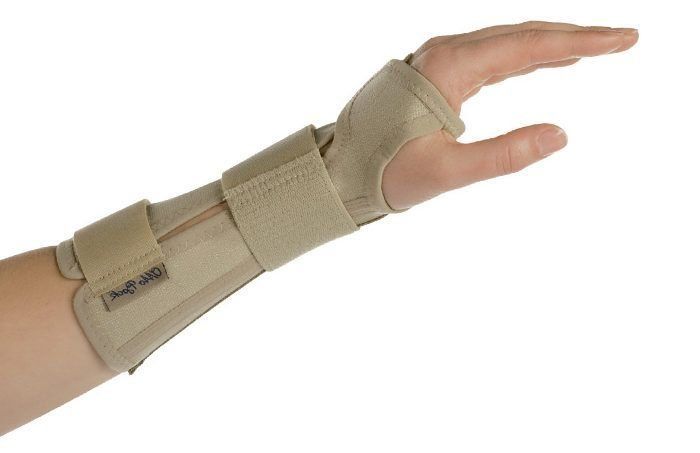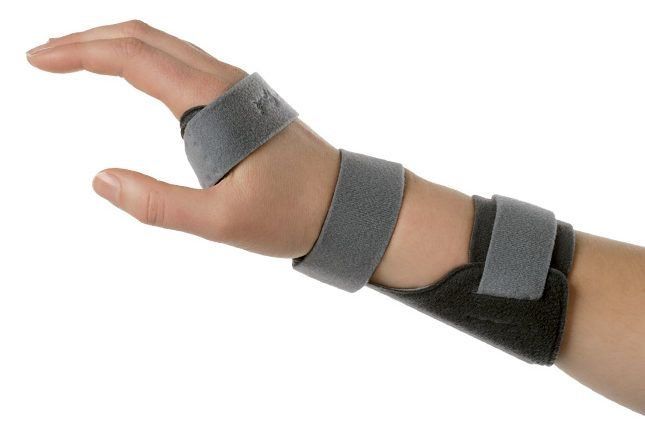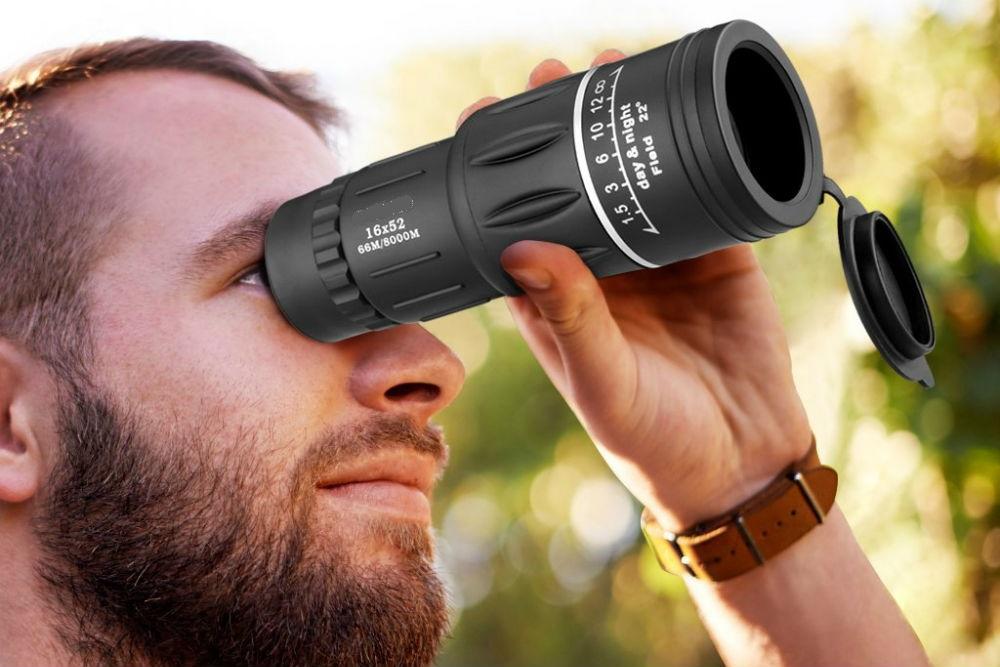Best wrist braces in 2020

The wrist is one of the most vulnerable places in the human body. At the same time, it takes on significant loads. In these conditions, various injuries of the wrist joint are not uncommon. To prevent them or speed up the recovery process, various bandages and orthoses are used. They have their own purpose and are used for different purposes. The rating of the best wrist bandages will help you to choose the most optimal one.
Purpose of the wrist band
The wearing of such an orthopedic device can be recommended in different situations. Often experts advise to wear it for people who have a hereditary predisposition to diseases of the bone structure of the wrist or if there are already any problems with this joint. These diseases include arthrosis, paralysis, paresis, polyarthritis and others. With the right choice of model, degree of rigidity and fixation, the device improves well-being, reduces pain, swelling and helps to correctly distribute the load on the sore spot. Clamps are worn for prophylaxis, to reduce the likelihood of an exacerbation of a chronic ailment or to improve hand performance.
The indications for the use of the bandage are:
- The need for a quick recovery from a wrist injury.
- Prevention of injury and rational distribution of the load.
- Reducing the likelihood of re-damage.
- Loads on the wrist due to the professional activities of a person. These can be various sports, dancing, construction and other professions where there is a high load on the hands.
To prevent damage, elastic retainers are usually used, while for the treatment of an existing injury, it is more expedient to use rigid bandages that reliably hold the injured joint in a certain position. In some cases, a rigid orthosis replaces a traditional cast. In contrast to the latter, the orthosis is much more comfortable, it can be removed at any time to carry out hygiene procedures.
Varieties of clamps
All orthopedic products for keeping the wrist joint in one position have their own differences in purpose and external features.
Soft wrist orthoses
These devices are in the form of a bandage, made of technological fabric, which has hypoallergenic properties and is capable of passing moisture. They are very elastic, protect the affected joint from damage, but do not limit its mobility. The brace prevents too much extension or flexion of the wrist and its rotation.This device creates a small degree of fixation, heats damaged tissues and has a massage effect in the area of its location. Still soft bandages are shown for prevention purposes.

It is justified to wear light elastic bands on the wrist for those people who work on the keyboard for a long time. They are especially good at helping to cope with tunnel syndrome. This disease develops imperceptibly and causes severe discomfort to people who spend most of their time working with a computer. The disease begins with a slight discomfort during extension or flexion of the hand. Ignoring this alarming signal results in sudden severe pain in the wrist, accompanied by numbness, tingling, or goose bumps. Temporary relief from unpleasant sensations is provided by wearing a soft bandage. Failure to properly treat this disease can cause disability.
Such orthoses are made in the form of gloves of different lengths, supplemented with a thumb holder. Stretchable and at the same time rigid tissue makes its own adjustments to the degree of hand mobility. They also use a thumb orthosis to keep it in one state. The soft bandage creates a safe finger position, relieves soreness, prevents swelling, and stimulates blood flow in the affected area of the hand.
Soft bandages allow you to correctly distribute the load taken by the joint and force the hand to assume its normal physiological state. Such devices protect athletes from possible injuries.
Indications for wearing a soft bandage:
- The recovery period after damage to the bones of the joint, if an inflammatory process is observed;
- Acceleration of recovery after joint operations;
- Ailments of the wrist joint, causing dystrophy and degeneration;
- Inflammation of muscles, joints and ligaments;
- Tunnel syndrome;
- Arthritis.
Combined orthosis
This is considered a transitional model. It is made of a special material with excellent stretch, hypoallergenic properties and breathable. To create a rigid structure, plates made of polymers or a metal alloy are sewn into the elastic fabric. They are located on the inside of the fixture. The brace allows you to keep the hand and fingers in a normal state and limits the spontaneous movement of the wrist. Such a device prevents the occurrence of contracture and normalizes the functioning of the hand.

Semi-rigid models create more movement restrictions than conventional elastic braces. It is recommended to wear such devices in the following situations:
- After surgical operations on the lower part of the forearm, tendons, ligamentous apparatus or wrist joint;
- To keep the hand in good condition after removing the cast;
- For rehabilitation after a stroke, when paresis or paralysis of the limbs is observed;
- To speed up the healing of tears or sprains.
Rigid structures
Such models allow you to hold the joint and fingers motionless and completely immobilize the hand. To achieve the required level of fixation in rigid models, metal plates, polymer elements, sleeves or hinges are provided. Usually, this orthosis is prescribed after a fracture.
The use of a rigid structure is justified in the following situations:
- After surgical treatment of the hand;
- With hand contracture due to tissue degeneration, inflammation or neurological diseases;
- For joint immobilization after muscle injury, ligament rupture and fracture;
- With exacerbation of rheumatism.

Joint diseases reduce the activity of hand movement, a person cannot independently control them. The patient has difficulty holding objects, cannot take them or make other simple movements. Penetrating pain in the wrist deprives a person of the ability to self-service.
To reduce these negative aspects, rigid orthoses are used.Such a splint does not allow tissues to move, directs movement in the joint and allows it to be fixed in its natural position.
How to choose the right orthosis
You cannot choose a product yourself. This should be done by the attending physician, because only he will be able to adequately assess the degree of damage and prescribe the most optimal device. All models differ in the degree of fixation rigidity and design features. Therefore, you need to try on the product for the first time under the supervision of a specialist.
Wrist braces are commercially available for the right and left hands, but there are also universal options. This must be considered before purchasing. You also need to measure your wrist, because it is by this measure that the bandages are divided by size. The tape should be run over the most prominent parts of the wrist. If you need to buy a device that fixes the brush, then you should also measure its girth. It should be borne in mind that the dimensional grids differ from manufacturer to manufacturer, so you need to navigate by measuring your own brush.
Bandage wearing rules
The doctor decides how many hours a day and how long to wear the orthopedic device. At first, after operations, it is generally impossible to do without it. The splint is worn constantly, removing it only in order to perform hygiene procedures. And even in this case, this can only be done with the approval of the attending physician.
As the damage from the bandage heals, it gradually begins to decline. The schedule for using the orthosis in this case is determined by a specialist.
If the model is used for prevention of injury, then it is worn immediately before work or training. Constant wearing in this case is not recommended, as it leads to muscle tissue atrophy. Do not violate the recommendations of the attending physician regarding the mode of wearing the bandage. This lengthens the rehabilitation and complicates the recovery process.
Care of the product
Each bandage must be accompanied by its own instructions on how to use it correctly. It is imperative that you familiarize yourself with it. A contaminated product should only be washed on hands using cool water and a mild detergent. Do not use bleach, twist the caliper or iron the fabric. It is necessary to dry the bandage only in a straightened state on a smooth horizontal surface.
List of the best models
Orliman MP-D72 / MP-I72
This device is a semi-rigid, shortened structure for keeping the wrist joint in the correct position. For the manufacture of such a bandage, cotton fabric is used, over which a waterproof material is applied. This device is worn to prevent injury and to treat it.
The product features a durable metal alloy tire and special palm inserts. Elastic fabric is used at the back. Convenience of putting on is provided by clips and Velcro fastener.

- keeps the wrist in the correct position;
- ease of use due to the elasticity of the material;
- reduces soreness after injuries and inflammation;
- promotes conservative joint treatment;
- wide size range;
- different models for right and left hand.
- high price.
The average cost of such a bandage is 2,420 rubles.
Orliman M600 / M700
The device has a very simple design. Breathable materials are used for its manufacture. The bandage consists of a velor strap, which is fastened with rings and a micro-Velcro fastener. The degree of fixation is adjusted by wrapping the strap around the injured wrist.

- the model provides rigid fixation;
- single option for right and left hands;
- available in different colors;
- used to recover from injuries;
- low price.
- has a limited list of indications.
The average cost of such a model is 1,350 rubles.
Medi Manumed active
This bandage is used to treat various injuries and diseases of the wrist. The wide strap limits wrist mobility, relieves pain and reduces ligament tension. The bandage has a moderate compressive effect, which improves blood flow and tissue oxygen supply. It reduces swelling and speeds up recovery.

- special three-dimensional knitting to wick moisture away from the skin;
- antibacterial action;
- tight fit and comfort when using;
- ergonomic design;
- a splint in the palm area supports the hand without tension;
- there is no strong pressure on the styloid process.
- high price.
The cost of this model of a bandage is 4600 rubles.
Medi wrist support
The orthosis is designed to treat various diseases and injuries of the joint, including chronic ones. It is also used for rehabilitation after plaster removal. The device is available for the right or left hand.

- anatomical design of the aluminum splint;
- it is possible to change the shape of the tire, adjusting to the individual characteristics of the human body;
- Lycra comfort cuff;
- Velcro fasteners allow you to quickly and securely fix the device on your hand.
- high price.
The average cost of such a product is 3600 rubles.
Otto Bock Manu 3D Stable
This brace is intended for the wrist joint, has an integrated plastic splint on the palm and a long wrist strap. The device is designed to accelerate rehabilitation after various joint injuries, as well as to treat acute and chronic joint diseases. It is used to treat tunnel syndrome and rheumatoid arthritis.
The device immobilizes with a medium degree of rigidity, allows better coordination of the work of the limb, stimulates recovery processes in the affected area. By wearing this bandage, it is possible to relieve pain and prevent unwanted deformation.

- the anatomical shape of the plastic splint;
- Durable Velcro fasteners for easy attachment
- you can adjust the density of the girth with a special belt;
- there is a spring insert to hold the thumb in the correct position;
- high-quality textiles of sufficient rigidity to create the necessary compression action;
- air and moisture permeable, hypoallergenic.
- high price.
The average cost of the model is 4490 rubles.
Otto Bock Manu Forsa Volar
This rigid wrist orthosis is equipped with a special metal splint and palm rest. It is recommended for the treatment of arthritis and arthrosis, for the rehabilitation of fractures, sprains and bruises. With the help of this device, it is possible to cure the tunnel syndrome, to speed up the rehabilitation after surgery.
The brace makes it possible to rigidly immobilize the wrist in the correct physiological position. It is possible to fix the brush in different positions. The device allows you to reduce soreness or completely eliminate it. Regular wearing of the orthosis helps prevent contracture and deformity.

- anatomical shape of the splint;
- circular straps and comfortable buckles for a tight grip on the working area;
- for the convenience of the location of the hand, it is possible to use a removable pad;
- attractive design and light weight;
- skin-friendly material with increased softness does not irritate the skin.
- expensive model.
The average cost of such a device is 4,900 rubles.
Choosing a model of a bandage for fixing a wrist, it is necessary to build on the recommendations of the attending physician and choose the right size. Only in this case the product will have the necessary positive impact.
new entries
Categories
Useful
Popular articles
-

Top rating of the best and inexpensive scooters up to 50 cubic meters in 2020
Views: 97661 -

Rating of the best materials for noise insulation for an apartment in 2020
Views: 95022 -

Rating of cheap analogues of expensive medicines for flu and colds for 2020
Views: 91750 -

The best men's running shoes in 2020
Views: 87680 -

Top ranking of the best smartwatches 2020 - price-quality
Views: 85091 -

Best Complex Vitamins in 2020
Views: 84801 -

The best dye for gray hair - 2020 top ranking
Views: 82406 -

Rating of the best wood paints for interior use in 2020
Views: 77202 -

Ranking of the best action cameras from China in 2020
Views: 75269 -

Rating of the best spinning reels in 2020
Views: 74827 -

The most effective calcium supplements for adults and children in 2020
Views: 72462 -

Top rating of the best means for male potency in 2020 with a description
Views: 68296









